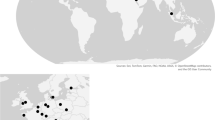Abstract
Among the numerous moisture sorption models, the GAB, an expanded version of the BET equation originally derived for inert gases adsorption on solid surfaces, is the most prominent. Both models are based on distinction between the adsorbate molecules settling on the bare surface in a monolayer (Langmuir adsorption) and those settling on already absorbed molecules forming multilayers. The BET theory has been successfully used to determine porous catalysts’ and fine powders’ specific surface area to this day. In contrast, applying the BET and GAB equations to water vapor sorption by solid foods (and non-foods) has at least three major problems: The calculated food powders’ specific surface area is independent of their particle size; the expected shoulder in foods’ enthalpy vs. moisture plot is absent; and there is a huge discrepancy between the specific surface areas calculated from moisture sorption isotherms and those of nitrogen. An alternative modeling approach posits the non-existence of a water monolayer, and suggests that moisture sorption is governed by at least two simultaneous mechanisms having different scaling exponents. Mathematical analysis and comparison of the resulting sorption models with the GAB equation show that they produce practically indistinguishable moisture sorption isotherms even with the same number of adjustable parameters. They also demonstrate that the sigmoid shape of a moisture sorption isotherm does not contain enough information to identify and quantify the underlying sorption mechanisms, and that a model’s good fit by statistical criteria in itself does not validate mechanistic assumptions.









Similar content being viewed by others
References
Agryropoulos D, Alex R, Kohler R, Muller J (2012) Moisture sorption isotherms and isosteric heat of sorption of leaves and stems of lemon balm (Melissa offcinalis) established by dynamic vapor sorption. LWT Food Sci Technol 47:324–331
Al-Muhtaseb AH, McMinn WAM, Magee TRA (2004) Water sorption isotherms of starch powders Part 1: mathematical description of experimental data. J Food Engn 61:297–307
Andrade RD, Lemus M, Perez CE (2011) Models of sorption isotherms for food: uses and limitations. Vitae 18:325–334
Barbosa-Canovas G, Vega-Mercado H (1996) Dehydration of foods Chapman and Hall, New York.
Barbosa-Cànovas G, Fontana AJ Jr, Schmidt SJ, Labuza TP (eds) (2007) Water activity in foods: fundamentals and applications IFT Press Series. Blackwell, Ames
Blahovec J, Yanniotis S (2008) GAB generalized equation for sorption phenomenon. Food Bioproc Tech 1:82–90
Boki K, Ohno S (1991) Moisture sorption hysteresis in kudzu starch and sweet potato starch. J Food Sci 56:125–127
Bonner IJ, Kenny KL (2013) Moisture sorption characteristics and modeling of energy sorghum (Sorghum bicolor (L.) Moench). J Stored Prod Res 52:128–136
Chirife J, Iglesias HA (1978) Equations for fitting isotherms of foods: part 1—a review. J Food Technol 13:159–174
Chirife J, Iglesias HA (1978) Equations for fitting water sorption isotherms of foods: part 1—a review. J Food Technol 13:159–174
Coupland JM, Shaw NB, Monahan FJ, O'Riordan OD, O'Sullivan M (2000) Modeling the effect of glycerol on the moisture sorption behavior of whey protein edible films. J Food Eng 43:25–30
Iglesias HA, Chirife J (1982) Handbook of food isotherms: water sorption parameters for food and food components. Academic Press, New York
Kaymak-Ertekin F, Gedik A (2004) Sorption isotherms and isosteric heat of sorption for grapes, apricots, apples and potatoes LWT Food. Sci Technol 37:429–438
Labuza TP (1968) Sorption phenomena in foods. Food Technol 22:15
Labuza TP (1984) Moisture sorption: practical aspects of isotherms measurement and use. AACC, St. Paul
Lewicki PT (1998) Three parameter equation for food moisture sorption isotherms. J Food Proc Eng 21:127–144
Lomauro CJ, Bakshi AS, Labuza TP (1985) Evaluation of food moisture sorption isotherm equations. Part 1: fruit, vegetable and meat products LWT Food. Sci Technol 18:111–117
Older I (2003) The BET-specific surface area of hydrated Portland cement and related materials. Cement Concrete Res 33:2049–2056
Palou E, Lopez-Malo A, Argaiz A (1997) Effect of temperature on the moisture sorption isotherms of some cookies and corn snacks. J Food Engng 31:85–93
Peleg M (1993) Assessment of a semi-empirical four parameter general model for sigmoid sorption isotherms. J Food Eng 16:21–37
Peleg M, Normand MD (1993) Estimation of the equilibrium water activity of multicomponent mixtures. Trends Food Sci Technol 3:157–160
Polachini TC, Beitol LFL, Lopes-Filho JF, Telis-Romero J (2016) Water adsorption isotherms and thermodynamic properties of cassava bagasse. Thermochimica Acta 632:79–85
Schuchmann H, Roy I, Peleg M (1990) Empirical models for moisture sorption isotherms at very high water activities. J Food Sci 55:759–762
Simatos D, Multon JL (1985) Properties of water in foods. Martinus Nijhoff Publ, Dordecht
Sormoli ME, TAG L (2015) Moisture sorption isotherms and net isosteric heat of sorption for spray-dried pure orange juice powder. LWT Food Sci Technol 62:875–882
Timmermann EO (2003) Multilayer sorption parameters: BET or GAB values? Colloid Surf A 220:235–260
van den Berg C (1985) Develoment of BET-like models for sorption of water on foods, theory and relevance. In: Simatos D, Multon JL (eds) Properties of water in foods. Martinus Nijhoff Publ, Dordecht
Włodarczyk-Stasiak M, Jamroz J (2008) Analysis of sorption properties of starch–protein extrudates with the use of water vapour. J Food Eng 85:580–589
Wolf W, Spiess WEL, Jung G (1985) Sorption isotherms and water activity of food materials. Elsevier, New York
Yanniotis S, Blahovec J (2009) Model analysis of sorption isotherms. LWT Food Sci Technol 42:1688–1695
Yogendrarajah P, Samapundo S, Devlieghere D, Saeger S, De Meulenaer B (2015) Moisture sorption isotherms and thermodynamic properties of whole black peppercorns (Piper nigrum L.). LWT Food Sci Technol 64:177–188
Zografi G, Kontny I, Yang AYS, Brenner GS (1984) Surface area and water vapor sorption of microcrystalline cellulose. Intnl J Pharma 18:99–116
Acknowledgements
The author thanks Mark D Normand for programming the Wolfram Demonstration and handling its submission.
Author information
Authors and Affiliations
Corresponding author
Additional information
Publisher’s Note
Springer Nature remains neutral with regard to jurisdictional claims in published maps and institutional affiliations.
Rights and permissions
About this article
Cite this article
Peleg, M. Models of Sigmoid Equilibrium Moisture Sorption Isotherms With and Without the Monolayer Hypothesis. Food Eng Rev 12, 1–13 (2020). https://doi.org/10.1007/s12393-019-09207-x
Received:
Accepted:
Published:
Issue Date:
DOI: https://doi.org/10.1007/s12393-019-09207-x




